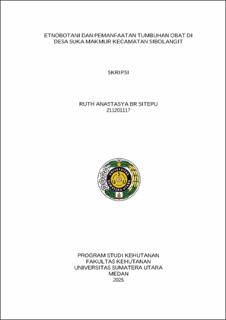Etnobotani dan Pemanfaatan Tumbuhan Obat di Desa Suka Makmur Kecamatan Sibolangit
Ethnobotany and the Use of Medicinal Plants in Suka Makmur Village, Sibolangit District,

Date
2025Author
Br Sitepu, Ruth Anastasya
Advisor(s)
Manurung, Harisyah
Rambey, Ridahati
Metadata
Show full item recordAbstract
Medicinal plants play an important role in maintaining and supporting the community's health system. This study aims to analyse the types of plants and methods of utilisation of medicinal plants by the Karo tribe community in Suka Makmur Village, Sibolangit District. An ethnobotanical approach was used in this study with quantitative and qualitative methods. Data were collected through semi-structured interviews using snowball sampling techniques, specimen collection, and plant identification. The results showed that the community utilised 120 types of medicinal plants from 46 families. The plant with the highest use value was Terbangun (Coleus amboinicus) at 0.80. The family with the highest use value was Anonaceae at 0.63. The most frequently utilised part of the plant was the leaves (54.92%), as they are easy to obtain and do not damage the plant. Based on a literature review of bioactive compound content, there are active compounds such as alkaloids, flavonoids, saponins, tannins, steroids, and triterpenoids, which support the effectiveness of utilising medicinal plants as a traditional treatment system in the village of Suka Makmur.
Collections
- Undergraduate Theses [2162]
